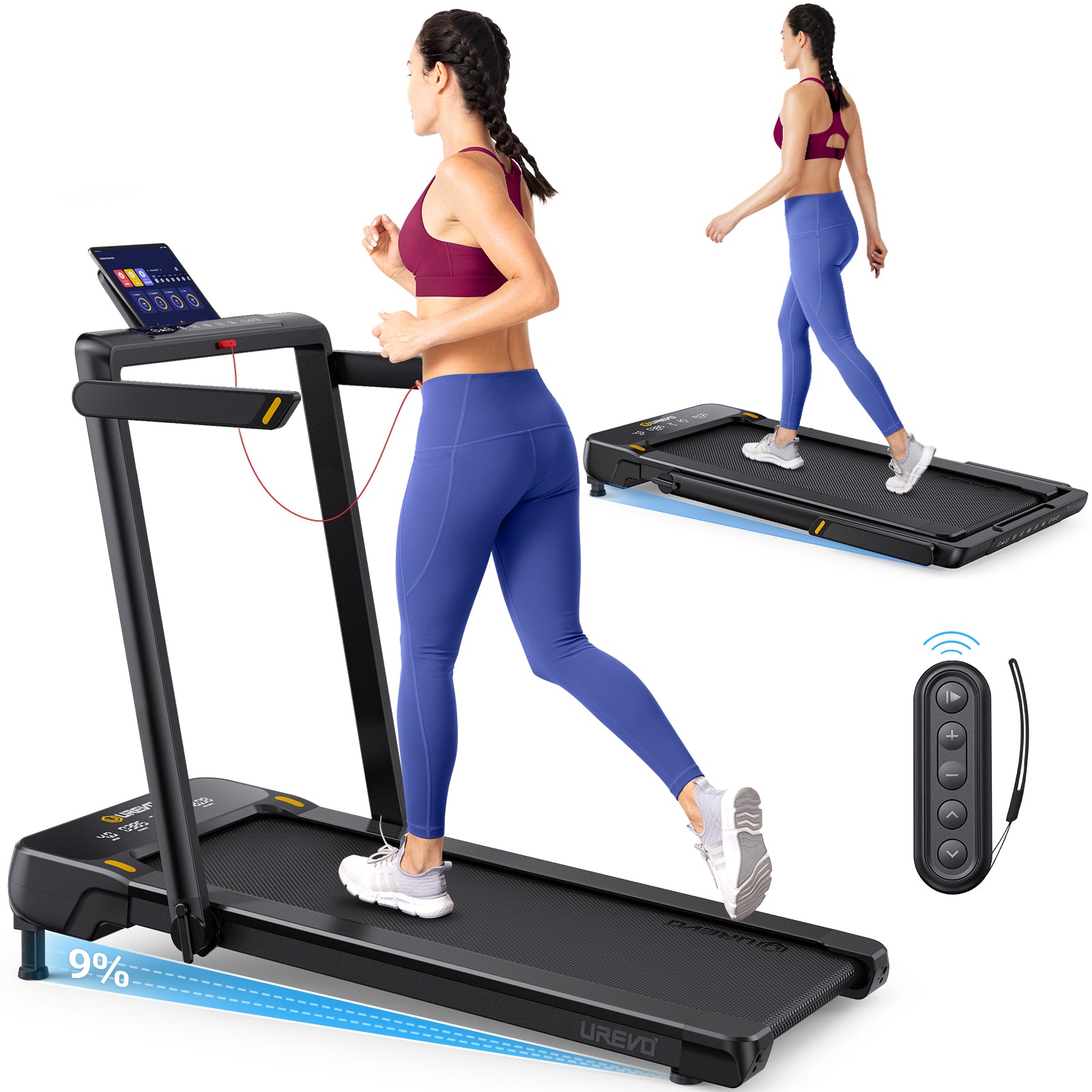People tirelessly seek countless strategies for weight loss or improved fitness. Among these, walking on an incline treadmill has garnered attention for its simplicity and effectiveness. We are writing this blog to tell you about incline treadmill walking, focusing on its benefits, optimal settings, and effective routines.
Advantages of Walking on an Incline Treadmill
Walking on an incline treadmill not only mirrors the benefits you'd get from a brisk walk but also amplifies them in several key areas.
- Caloric Burn: When you increase the incline on a treadmill, your body faces more resistance from gravity. This requires more effort from your muscles, leading to higher energy expenditure. For instance, walking at a 5% incline can increase your calorie burn by approximately 50% compared to walking on a flat surface.
- Muscle Toning and Strengthening: Incline walking specifically targets the lower body muscles more intensely than flat-surface walking. By elevating the treadmill, your glutes, quadriceps, and calves engage more deeply with each step. Regular incline walking can result in better muscle definition and strength in these areas, which are often less impacted by normal walking.
- Joint Health: Unlike the high impact of running, walking on an incline provides a low-impact but effective cardiovascular workout. This means you can enjoy the heart-pumping benefits of a strenuous workout without putting undue stress on your joints. It's particularly beneficial for those with knee problems or older adults seeking to maintain fitness without risk.
- Cardiovascular and Endurance Improvements: Regular incline walking boosts heart health by making it work harder to supply oxygen to your muscles. Over time, this can lead to improved heart efficiency and increased stamina. A consistent routine can gradually enhance your overall endurance, allowing you to perform physical activities for longer periods without fatigue.
What Is a Good Incline to Walk on a Treadmill
If you are beginners, starting at a modest incline of 2% to 5% is recommended. This range helps you adapt to the new challenge without overwhelming your body or causing strain. Things, however, are different for regular exercisers. As your body becomes accustomed to the incline, gradually increasing it to between 10% and 15% can offer more pronounced benefits in calorie burning and muscle strengthening. For example, an incline of 10% can boost your calorie expenditure by up to 3.5 times compared to flat walking, depending on your speed and body weight.
No matter what, do adjust the incline based on how your body feels during the exercise. An incline that is too steep can lead to muscle strain or discomfort, particularly in the lower back and hips. Find a balance where the intensity is challenging yet manageable to maintain consistency in your workouts.

Is It OK to Walk on an Incline Treadmill Every Day?
Walking on an incline treadmill every day is generally safe if you are mindful about varying your workout's intensity and listening to your body's signals. To avoid overuse injuries, integrate days of lower intensity or different types of exercise to ensure adequate muscle recovery. For those starting or those with existing health concerns, it's better to discuss any new exercise plans with a healthcare provider.
Does 12/3/30 Really Work for Weight Loss?
The 12/3/30 workout, popularized on social media, involves walking at a 12% incline, 3 mph speed, for 30 minutes. This routine is praised for its simplicity and effectiveness in burning calories and building stamina. But does it live up to the hype?
Indeed, the 12/3/30 can be a potent tool for weight loss, primarily due to its high caloric burn and ability to increase metabolic rate. However, its success also relies on consistency and a balanced diet. As with any exercise program, the best results come from a tailored approach that considers an individual's unique physical condition and fitness goals.
How Many Calories Can 12/3/30 Workout Burn
The 12/3/30 workout typically burns between 250 to 400 calories in a 30-minute session. This estimation varies based on individual factors such as body weight, age, gender, and overall fitness level. A person weighing around 155 pounds might burn approximately 250 to 300 calories, while someone weighing 185 pounds could burn between 300 to 400 calories. Regular participation and maintaining a consistent schedule enhance the total caloric burn and contribute to weight loss and fitness improvements.
How Many Times a Week Should I Do 12 3 30 to Lose Weight?
To capitalize on the benefits of the 12/3/30 workout for weight loss, aim to incorporate it into your routine three to four times per week. This frequency allows for significant calorie burn while providing enough rest days to prevent fatigue and injury. Combining this with strength training and other cardiovascular exercises can also enhance overall fitness and accelerate weight loss.

How Can You Adjust The 12/3/30 Workout To Target Specific Muscle Groups?
You can incorporate a few variations and additional exercises:
1. Modify the Incline and Speed
- Lower Body Focus (Glutes and Hamstrings): Increase the incline beyond 12% to put more emphasis on the glutes and hamstrings. The higher the incline, the more these muscles have to work.
- Calf Focus: Lower the incline slightly and raise the speed, focusing on pushing off with the balls of your feet. This adjustment helps engage the calf muscles more intensely.
2. Use Hand Weights
- Upper Body Engagement: Carry light hand weights (1-5 pounds) and perform arm exercises like bicep curls, shoulder presses, or tricep extensions while walking. This not only increases the calorie burn but also engages the upper body muscles.
3. Change Walking Style
- Sideways or Backward Walking: Walk sideways to target your inner and outer thigh muscles or walk backward (carefully) to challenge your hamstrings and glutes differently. This should be done at a reduced speed for safety.
4. Incorporate Intervals
- Mixed Intensity: Alternate between walking at the 12/3/30 setting for 5 minutes and then adding a minute of a higher intensity, such as a faster walk or a higher incline. This can help in engaging different muscle groups and increasing overall stamina.
5. Post-Workout Strength Training
- Specific Muscle Groups: After completing the treadmill workout, focus on strength training specific muscle groups. For example, doing squats, lunges, or leg presses will further target the lower body, while push-ups, pull-ups, or dumbbell rows will focus on the upper body.
6. Add Core Workouts
- Abdominal Exercises: Incorporate abdominal exercises post-walk. Planks, Russian twists, or bicycle crunches can be effective in strengthening the core, which is less directly affected by treadmill walking.
7. Mindful Walking
- Engage Core: While walking, consciously engage your core muscles. Maintaining a tight core throughout the walk can help in strengthening the midsection and improving overall posture.
Through these modifications, you can tailor the 12/3/30 workout to better suit your fitness goals and focus on developing specific muscle groups. Each change should be introduced gradually to assess how your body responds.
Final Words
Incline treadmill walking presents a compelling option for those seeking efficient and effective weight loss and fitness improvements. By adjusting the incline and frequency of workouts, you can tailor the experience to your needs and goals. Whether incorporating the 12/3/30 method or a more personalized incline walking routine, the key is consistency and enjoyment in your fitness journey.
Read More
- Portable Treadmill with Incline Available: Urevo's Innovation
- Is the Treadmill Walking Pad Effective? Exploring Benefits and Drawbac – Urevo
- 8 Reasons Why UREVO is Considered the Best Treadmill for Under Desk – Urevo
- How Many Steps a Day Should You Walk? – Urevo
- How Can You Burn Calories at Work? – Urevo

























